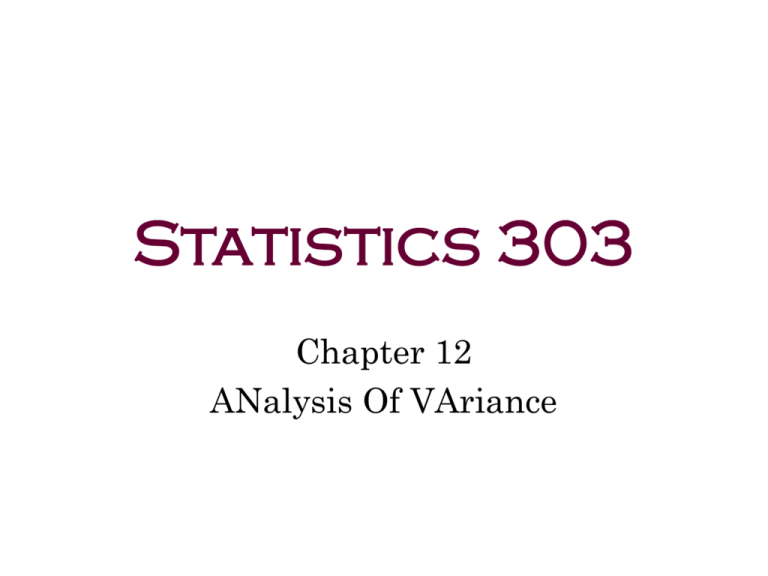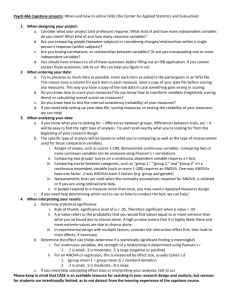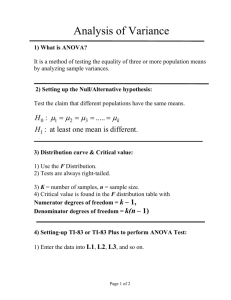Statistics 303
advertisement

Statistics 303 Chapter 12 ANalysis Of VAriance ANOVA: Comparing Several Means • The statistical methodology for comparing several means is called analysis of variance, or ANOVA. • In this case one variable is categorical. – This variable forms the groups to be compared. • The response variable is numeric. • This methodology is the extension of comparing two means. ANOVA: Comparing Several Means • Examples: – “An investigator is interested in studying the average number of days rats live when fed diets that contain different amounts of fat. Three populations were studied, where rats in population 1 were fed a high-fat diet, rats in population 2 were fed a medium-fat diet, and rats in population 3 were fed a low-fat diet. The variable of interest is ‘Days lived.’” (from Graybill, Iyer and Burdick, Applied Statistics, 1998). – “A state regulatory agency is studying the effects of secondhand smoke in the workplace. All companies in the state that employ more than 15 workers must file a report with the agency that describes the company’s smoking policy. In particular, each company must report whether (1) smoking is allowed (no restrictions), (2) smoking is allowed only in restricted areas, or (3) smoking is banned. In order to determine the effect of secondhand smoke, the state agency needs to measure the nicotine level at the work site. It is not possible to measure the nicotine level for every company that reports to the agency, and so a simple random sample of 25 companies is selected from each category of smoking policy.” (from Graybill, Iyer and Burdick, Applied Statistics, 1998). Assumptions for ANOVA 1. Each of the I population or group distributions is normal. -check with a Normal Quantile Plot (or boxplot) of each group 2. These distributions have identical variances (standard deviations). -check if largest sd is > 2 times smallest sd 3. Each of the I samples is a random sample. 4. Each of the I samples is selected independently of one another. ANOVA: Comparing Several Means The null hypothesis (step 1) for comparing several means is H0 : 1 2 I where I is the number of populations to be compared The alternative hypothesis (step 2) is H a : not all of the i are equal (at least one of the means is different from the others) ANOVA: Comparing Several Means • Step 3: State the significance level • Step 4: Calculate the F-statistic: Mean Squares Group MSG F or Mean Squares Error MSE This compares the variation between groups (group mean to group mean) to the variation within groups (individual values to group means). This is what gives it the name “Analysis of Variance.” ANOVA: Comparing Several Means • Step 5: Find the P-value – The P-value for an ANOVA F-test is always one-sided. – The P-value is Pr( Fdf1 ,df2 Fcalculated ) where df1 = I – 1 (number of groups minus 1) and df2 = N – I (total sample size minus number of groups). P-value F-distribution: ANOVA: Comparing Several Means • Step 6. Reject or fail to reject H0 based on the P-value. – If the P-value is less than or equal to a, reject H0. – It the P-value is greater than a, fail to reject H0. • Step 7. State your conclusion. – If H0 is rejected, “There is significant statistical evidence that at least one of the population means is different from another.” – If H0 is not rejected, “There is not significant statistical evidence that at least one of the population means is different from another.” ANOVA Table Source df Sum of Squares Group (between) I–1 ni ( xi x )2 SSG SSG MSG dfG Error (within) N–I (n 1)s SSE MSE dfE Total N–1 i (x i 2 SSE 2 x ) SSTot ij Mean Square F p-value MSG Fcalc MSE Pr( F Fcalc ) SSTot MST dfTot Note: MSE is the pooled sample variance and SSG + SSE = SSTot R2 SSG SSTot is the proportion of the total variation explained by the difference in means ANOVA: Comparing Several Means • Example: “An experimenter is interested in the effect of sleep deprivation on manual dexterity. Thirty-two (N) subjects are selected and randomly divided into four (I) groups of size 8 (ni). After differing amount of sleep deprivation, all subjects are given a series of tasks to perform, each of which requires a high amount of manual dexterity. A score from 0 (poor performance) to 10 (excellent performance) is obtained for each subject. Test at the a = 0.05 level the hypothesis that the degree of sleep deprivation has no effect on manual dexterity.” (from Milton, McTeer, and Corbet, Introduction to Statistics, 1997) ANOVA: Comparing Several Means • Information Given Stddev1 = 0.89316 Stddev2 = 0.86603 Stddev3 = 0.64507 Stddev4 = 0.85206 Sample size: N = 32 Group I Group II Group III Group IV 16 hours 20 hours 24 hours 28 hours 8.95 7.7 5.99 3.78 8.04 5.81 6.79 3.35 7.72 6.61 6.43 2.45 6.21 6.07 5.85 4.27 6.48 8.04 5.78 4.87 7.81 5.96 7.6 3.14 7.5 7.3 5.78 3.98 6.9 7.46 6 2.47 Variation between groups Variation within groups Side by Side Boxplots 9.00 8.00 7.00 6.00 5.00 4.00 3.00 2.00 GroupI GroupII GroupIII GroupIV 1.5 1.5 1.0 1.0 Expected Normal Expected Normal Normal Quantile Plots 0.5 0.0 -0.5 0.5 0.0 -0.5 -1.0 -1.0 -1.5 -1.5 6.0 6.5 7.0 7.5 8.0 8.5 9.0 6.0 6.5 Observed Value 7.0 7.5 8.0 Observed Value 1.5 1.5 1.0 Expected Normal Expected Normal 1.0 0.5 0.0 0.5 0.0 -0.5 -0.5 -1.0 -1.0 -1.5 5.5 6.0 6.5 7.0 Observed Value 7.5 8.0 2.0 2.5 3.0 3.5 Observed Value 4.0 4.5 5.0 ANOVA: Comparing Several Means • Information Given 7.45 Error Bars show Mean +/- 1.0 SE 6.87 7.00 Dot/Lines show Means 6.28 6.00 dexter Variation Within Groups 5.00 4.00 3.54 16 hours 20 hours 24 hours deprived 28 hours Average Within Group Variation (MSE) ANOVA: Comparing Several Means • Information Given 7.00 Dot/Lines show Means dexter Variation Between Groups Average Between Group Variation (MSG) 6.00 5.00 4.00 16 hours 20 hours 24 hours deprived 28 hours ANOVA: Comparing Several Means Step 1: The null hypothesis is H0 : 1 2 3 4 Step 2: The alternative hypothesis is H a : not all of the i are equal Step 3: The significance level is a = 0.05 ANOVA: Comparing Several Means • Step 4: Calculate the F-statistic: Mean Square Group MSG F or Mean Square Error MSE 23.976 35.73 0.671 MSG and MSE are found in the ANOVA table when the analysis is run on the computer: ANOVA MSE MSG DEXTER Between Groups Within Groups Total Sum of Squares 71.928 18.789 90.716 df 3 28 31 Mean Square 23.976 .671 F 35.730 Sig. .000 ANOVA: Comparing Several Means • Step 5: Find the P-value – The P-value is Pr( Fdf1 ,df2 Fcalculated ) Pr( Fdf1 ,df2 35.73) .0001 where df1 = I – 1 (number of groups minus 1) = 4 – 1 = 3 and df2 = N – I (total sample size minus I) = 32 – 4 = 28 ANOVA DEXTER Between Groups Within Groups Total Sum of Squares 71.928 18.789 90.716 df 3 28 31 Mean Square 23.976 .671 F 35.730 Sig. .000 35.73 ANOVA: Comparing Several Means • Step 6. Reject or fail to reject H0 based on the Pvalue. – Because the P-value is less than a = 0.05, reject H0. • Step 7. State your conclusion. – “There is significant statistical evidence that at least one of the population means is different from another.” An additional test will tell us which means are different from the others.







